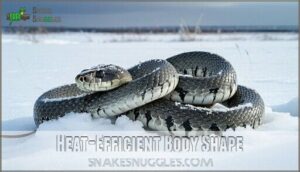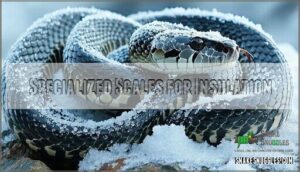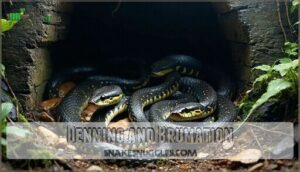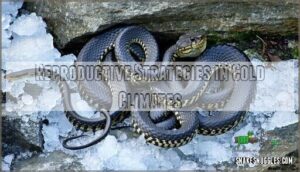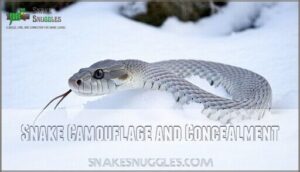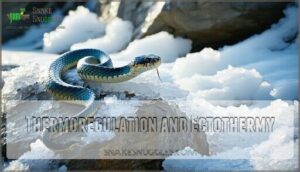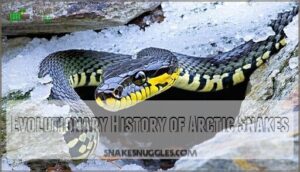This site is supported by our readers. We may earn a commission, at no cost to you, if you purchase through links.
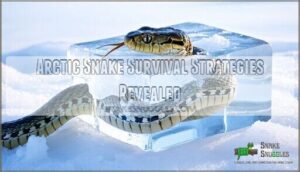
These cold-blooded creatures develop heat-efficient body shapes, specialized insulating scales, and antifreeze proteins in their blood to prevent deadly ice crystal formation.
They master behavioral thermoregulation by basking strategically and seeking thermal refuges.
During brutal winters, they enter brumation—a snake’s version of hibernation—where metabolism drops dramatically and they become living ice sculptures.
Their reproductive strategies shift to viviparity, keeping eggs warm inside their bodies rather than risking frozen nests.
What’s truly fascinating is how these serpents have cracked the code of freeze tolerance.
Table Of Contents
- Key Takeaways
- Adaptations for Arctic Survival
- Snake Hibernation Strategies
- Surviving Extreme Cold
- Reproductive Strategies in Cold Climates
- Snake Camouflage and Concealment
- Finding Food in The Arctic
- Thermoregulation and Ectothermy
- Arctic Snake Migration and Dispersal
- Evolutionary History of Arctic Snakes
- Frequently Asked Questions (FAQs)
- How do snakes survive in cold climates?
- Can snakes survive in the Arctic?
- What helps a snake survive?
- What are the secrets of snakes survival?
- How do snakes survive extreme cold?
- What are the adaptations of a snake to survive?
- What are snakes survival skills?
- What helps a snake survive in the wild?
- Can Arctic snakes survive in warmer climates if relocated?
- How do Arctic snakes protect themselves from predators in the wild?
- Conclusion
Key Takeaways
- You’ll find that arctic snakes develop heat-efficient body shapes, specialized insulating scales, and antifreeze proteins in their blood to prevent deadly ice crystal formation, which helps them survive in extreme cold.
- They master behavioral thermoregulation by basking strategically, seeking thermal refuges, and using shelter to conserve energy and regulate their body temperature.
- Arctic snakes have evolved unique reproductive strategies, such as viviparity, to keep their babies safe and warm in cold climates, and they’ve also developed clever tricks like extended gestation and specialized uteruses to support embryo development.
- You’ll discover that these snakes use camouflage and clever behavior, and natural shelters to stay safe and almost invisible in their snowy environments, and they’ve even developed supercooling mechanisms to prevent their blood from freezing in extreme cold.
Adaptations for Arctic Survival
You’re about to explore the amazing adaptations that help arctic snakes survive in one of the coldest places on Earth.
As you learn about these adaptations, you’ll discover how arctic snakes use specialized body shapes, scales, and blood properties to stay warm and thrive in extreme cold.
Heat-Efficient Body Shape
Picture a coiled rope—Arctic snakes use a heat-efficient body shape to battle the chill.
By minimizing surface area and maximizing thermal mass, they boost body insulation and heat retention. Packed fat and dense muscles help regulate body temperature and metabolic rate.
Arctic snakes turn their bodies into living thermal batteries—fat and muscle packed tight for maximum heat storage.
It’s cold tolerance with a twist—no scarves needed!
- Body Insulation keeps warmth in
- Thermal Mass slows heat loss
- Heat Retention aids survival
- Shape supports metabolic rate regulation
Specialized Scales for Insulation
Arctic snakes have mastered the art of staying warm through their specialized scales. These remarkable insulation layers work like nature’s own thermal blanket, creating multiple air pockets that trap heat close to the body.
Here’s how their scale morphology enables cold adaptation:
- Overlapping design: Scales layer like shingles, creating dead air spaces that prevent heat loss
- Increased thickness: Thicker scales in arctic species provide enhanced thermal regulation compared to temperate cousins
- Surface texture: Rough scale surfaces trap more air, boosting reptile insulation techniques substantially
This snake thermoregulation system works so well that some species can maintain core body temperature even when ambient temperatures drop below freezing.
Cold-Resistant Blood Properties
While specialized scales provide the first line of defense, you’ll discover that snakes’ blood holds the real secret to antifreeze proteins and cryoprotectants.
Nature’s ultimate antifreeze flows through arctic snake veins, keeping them alive when ice crystals spell death.
These remarkable molecules prevent deadly ice crystals from forming in their bloodstream.
Their specialized hemoglobin maintains fluid circulation even when temperatures plummet, allowing freeze tolerance that keeps them alive when other animals would perish.
Behavioral Adaptations for Thermoregulation
Survival in arctic conditions requires smart behavioral choices.
Snakes master thermal regulation through four key strategies:
- Sun basking: They position themselves in sunny spots to absorb warmth, maximizing heat seeking opportunities when temperatures allow.
- Huddle formation: Groups gather together during cold periods, sharing body heat through collective thermoregulatory behavior that reduces individual energy loss.
- Shelter use: Snakes retreat into burrows, rock crevices, or underground spaces for cold avoidance, finding stable temperatures below the frost line.
- Activity patterns: They time their movements strategically, remaining active during warmer periods and reducing movement when temperatures drop.
These behavior adaptations work together as an integrated system.
Body temperature regulation depends on external heat sources since snakes can’t generate their own warmth.
Smart basking behavior combined with effective shelter use helps them survive harsh arctic conditions while conserving precious energy reserves.
Snake Hibernation Strategies
When winter hits, you’ll find Arctic snakes entering a state called brumation—their version of hibernation that’s perfectly tuned for cold survival.
They’ll slow their breathing and heart rate to almost nothing, becoming living ice sculptures that can survive months without food or much movement, utilizing a unique adaptation for cold survival.
Denning and Brumation
When temperatures drop, you’ll find snakes gathering in denning sites like abandoned burrows or rock crevices below the frost line.
This brumation process slows their heart rate and breathing dramatically. Think of it as nature’s pause button – snakes can survive months without food while staying barely awake.
Hibernation sites become cozy underground hotels where dozens huddle together for warmth and winter survival.
Snakes often prepare for this period by understanding rattlesnake brumation patterns to increase their chances of survival.
Energy Conservation Techniques
When temperatures drop, snakes become masters of energy conservation through dramatic metabolic slowdown.
Their heart rate plummets and breathing nearly stops during hibernation.
Think of it as nature’s ultimate power-saving mode! Cryoprotectants and thermal insulation from group denning help maintain essential functions while burning minimal calories throughout winter’s harsh grip.
Physiological Changes During Hibernation
When you hibernate, your body becomes a master of energy conservation.
Your metabolic rate drops dramatically, sometimes by up to 95%, while your heart rate slows to just a few beats per minute.
Body temperature plummets to match your surroundings, and blood flow gets redirected away from non-essential organs.
This hibernation physiology represents the ultimate cold adaptation strategy.
Hibernation Site Selection
Finding the perfect hibernation spot is like choosing a winter bunker. Arctic snakes can’t just crash anywhere when temperatures plummet.
They need Den Site Selection that prioritizes Thermal Stability below the frost line. Smart hibernation means locating Hibernacula Design that offers Freeze Protection through strategic Burrow Systems.
- Underground real estate: Snakes seek hibernacula below frost line using old mammal burrows or crayfish holes
- Group housing: Multiple snakes share denning sites for warmth and energy conservation during brumation
- Water table wisdom: Sites with high water tables resist sudden temperature changes better
- Predator-proof locations: Remote spots away from winter-active predators guarantee safer arctic snake hibernation strategies
- Thermal pockets: Rock crevices and deep soil provide stable microhabitats for extended hibernation periods
Surviving Extreme Cold
You’ll discover that Arctic snakes have developed remarkable freeze-tolerance abilities that let them survive when nearly half their body water turns to ice.
These cold-weather champions use antifreeze proteins and special molecules called cryoprotectants to keep their cells from getting damaged during the harshest winter conditions.
Freeze Tolerance and Freeze Avoidance
You’re witnessing nature’s ultimate cold adaptation showdown!
Arctic snakes deploy freeze tolerance and freeze avoidance like dual shields against ice formation.
Freeze tolerance lets them survive with up to 40% of body water frozen, while freeze avoidance uses cryoprotectants and supercooling to prevent ice crystals entirely.
These thermal regulation strategies showcase incredible cryoprotection mechanisms that keep these reptiles alive when temperatures plummet below survival thresholds.
Antifreeze Proteins in Snake Blood
Just like a secret recipe in Grandma’s kitchen, snakes have a special ingredient in their blood: antifreeze proteins.
These clever molecules—part of cold-resistant blood composition—grab onto ice crystals, stopping them from growing.
Think of them as molecular mittens, using their unique protein structure and binding to help with freeze prevention.
That’s cold adaptation—and it’s brilliant!
Snakes also exhibit remarkable venom evolution mechanisms that have contributed to their survival in various environments.
Supercooling and Ice Nucleation
Before you start picturing frozen snakesicles, let’s talk about how these reptiles stick it to the cold.
Thanks to supercooling mechanisms and antifreeze proteins, their blood stays liquid well below freezing. It’s textbook freeze tolerance with a twist—snakes use these ice-blocking tricks to survive Arctic chills.
Understanding the temperature threshold limits is essential for their survival in extreme cold conditions.
- Cells dodge ice formation.
- Ice nucleation gets the cold shoulder.
- Supercooling? Mission accomplished!
Cryoprotectants and Their Role
You might think only cars need antifreeze, but Arctic snakes have cryoprotectant molecules that work overtime.
These natural antifreeze proteins keep cells safe by stopping ice formation, helping with freeze prevention and sparkling cellular protection. It’s freeze tolerance at its best.
Explore how cryoprotectants and supercooling make snake blood winter-ready:
| Cryoprotectant | Function | Supercooling Role |
|---|---|---|
| Glycerol | Prevents ice | Enhances cell safety |
| Glucose | Lowers freezing | Boosts freeze tolerance |
| Antifreeze Protein | Stops crystals | Supports supercooling |
| Sorbitol | Stabilizes cells | Improves cold response |
Reproductive Strategies in Cold Climates
You might think snakes would rather skip romance when it’s freezing, but they’ve developed some clever tricks to keep their babies safe.
In the Arctic, you’ll see snakes using live birth and extra-long pregnancies—like cold-blooded parents waiting for the perfect warm moment.
Viviparity and Oviparity
You’re exploring Arctic snakes’ reproductive strategies, which include viviparity, giving live birth, and oviparity, laying eggs.
Key points include:
- Viviparity aids thermoregulation
- Oviparity is less common
- Live birth helps survival
- Egg laying has drawbacks
- Reproductive modes adapt to climate
Embryonic Development and Thermoregulation
Snake moms are experts at keeping their eggs cozy. They use Embryo Insulation and clever thermoregulation to guard against Cold Shock.
When the Arctic chills hit, development slows, giving embryos a fighting chance. These Developmental Adaptations, like Cryoprotection, boost Thermal Tolerance and help cold blooded survival.
Arctic snake physiology is all about smart embryonic development.
| Term | What It Means |
|---|---|
| Embryo Insulation | Keeps eggs warm |
| Cold Shock | Sudden temperature drop |
| Cryoprotection | Cells resist freezing |
| Thermal Tolerance | Survive temperature swings |
Reproductive Adaptations for Survival
Arctic snakes have evolved unique reproductive strategies to thrive in icy conditions.
Here’s how they do it:
- Viviparity: Live birth shields offspring from the cold.
- Extended Gestation: Longer development guarantees stronger babies.
- Specialized Uterus: Nutrient transfer boosts embryo development.
These reproductive strategies, including viviparity and extended gestation, are key to their survival.
By focusing on embryo development and thermoregulation, these snakes give their young a head start in the harsh Arctic.
Mating and Breeding Habits
You’re about to uncover arctic snake mating habits. They’ve short breeding seasons with unique courtship rituals, involving mate selection and viviparity, showcasing fascinating reproductive cycles and breeding habits.
Understanding the role of temperature dependent sex is vital here, with some species exhibiting venom, influencing arctic snake habits and snake migration patterns.
| Habit | Season | Duration |
|---|---|---|
| Mating | Spring | 2 weeks |
| Breeding | Summer | 3 months |
| Hibernation | Winter | 6 months |
Snake Camouflage and Concealment
When you scan a snowy landscape, you mightn’t spot an Arctic snake—its patterns and colors are so sneaky, they’d win a game of hide-and-seek against a snowman.
You’ll see how these snakes use camouflage, clever behavior, and even borrowed burrows to stay safe, warm, and almost invisible, utilizing clever behavior to achieve this.
Coloration and Pattern Adaptations
After baby snakes are born, how do they hide? You’d be amazed by their camo! Coloration and patterns are nature’s tricks.
They use crypsis to match surroundings. Some use mimicry looking like something else. You might see countershading breaking up their shape or disruptive coloration confusing predators.
Pattern variation is key. It’s all about adaptive hue and cryptic markings.
- A gasp of surprise
- A knowing nod
- A quiet smile
- A moment of awe
Snow and Ice Camouflage
You’ll discover Arctic snakes’ amazing snow and ice camouflage, utilizing seasonal coloration and disruptive patterns for crypsis, helping them avoid predators with effective subnivean camouflage strategies.
Making them nearly invisible in snowy environments through clever crypsis strategies and snow camouflage methods.
Behavioral Adaptations for Concealment
You’ll witness Arctic snakes using mimicry tactics, such as freezing in place or flattening against the ground, to conceal themselves.
They employ:
- Burrow usage
- Shelter selection
- Camouflage behavior
- Nocturnal activity
- Snow camouflage, showcasing clever behavioral adaptations for concealment.
To enhance their camouflage, some species exhibit disruptive patterns to break up their outline, utilizing disruptive patterns to remain hidden.
Use of Natural Shelters and Burrows
Beyond camouflage, Arctic snakes ace shelter use. You’d be amazed by their skill at using natural shelters. They’re not just hiding; they’re surviving.
Here’s how they do it:
- Rock crevices offer winter dens.
- Abandoned animal burrows provide predator avoidance.
- Snow-covered vegetation creates hibernation sites.
Burrow microclimates are their jam. Shelter construction isn’t their thing. Burrow use is key for thermal refugia and predator avoidance. Habitat availability matters!
Finding Food in The Arctic
You’re about to explore how arctic snakes find food in one of the harshest environments on Earth.
As you learn about their hunting strategies and tactics, you’ll discover how they conserve energy and adapt to their prey in the arctic landscape, which involves complete concepts of survival.
Hunting Strategies and Tactics
You’re about to uncover Arctic snakes’ hunting secrets.
They use ambush tactics, relying on sensory adaptations for strike precision, making them efficient predators with minimal energy expenditure, showcasing their impressive ambush predation skills.
Utilizing the right snake hunting equipment is essential for researchers studying these elusive creatures.
Prey Selection and Adaptation
You’re now exploring prey selection and adaptation.
Arctic snakes adjust their hunting strategies based on prey availability.
They
- Target hibernating prey
- Adapt venom
- Use snow camouflage to ambush prey, maximizing hunting efficiency amidst seasonal variation, which is a key aspect of their adaptation.
Energy Conservation During Hunting
You’ll find arctic snakes using ambush tactics for energy conservation.
They lie in wait, reducing movement for efficient digestion, and adjusting venom based on prey availability during the hunting season, optimizing their metabolic rate.
Scavenging and Opportunistic Feeding
You’ll use scavenging as a tactic.
Here’s how:
- Sniffing out carrion
- Competing with scavengers
- Adjusting gut bacteria.
This dietary flexibility helps during winter foraging when prey availability is low, showcasing arctic survival tactics, particularly with scavenging.
Thermoregulation and Ectothermy
You’re about to learn how arctic snakes regulate their body temperature in extreme cold.
As you explore thermoregulation and ectothermy, you’ll discover the unique strategies these snakes use to survive.
From basking in the sun to behavioral adaptations that help them conserve energy, these strategies are crucial for their survival.
External Temperature Regulation
You regulate your body temperature like Arctic snakes, using environment to stay warm.
| Method | Description | Effect |
|---|---|---|
| Heat exchange | absorb heat | warm up |
| Body size | larger snakes | retain heat |
| Thermal tolerance | function at low temps | survive |
| Shelter Use | hide from wind | reduce heat loss |
| Surface Contact | warm surfaces | gain heat |
Basking and Sun Exposure
You’re soaking up sunshine like Arctic snakes, maximizing heat absorption with strategic positioning.
Basking benefits include ideal temperatures for digestion and movement, but beware of sun exposure risks, seeking shelter when needed to maintain stable body temperature through thermal regulation.
Behavioral Thermoregulation
After basking helps warm them up snakes also show off some cool moves.
You’ll see them use behavioral thermoregulation to stay comfy.
Think of it as their personal climate control.
Basking behavior is key.
They also use sheltering to avoid overheating.
Burrow usage offers a cozy escape.
Huddling strategies help share warmth.
Orientation adjustments maximize sun.
Brumation patterns conserve energy.
Snakes choose microhabitat preferences carefully for thermoregulation.
Physiological Adaptations for Thermoregulation
You’ll discover arctic snakes’ cool secrets.
They control blood flow, have temperature-savvy enzymes, and utilize scale insulation, fat layers, and muscle density for thermoregulation.
This showcases metabolic flexibility and cold tolerance in harsh climates.
Arctic Snake Migration and Dispersal
You’re about to explore how Arctic snakes migrate and disperse, which is essential for their survival.
As you learn about their migration patterns, you’ll discover how they adapt to new habitats and environments, which is pretty cool, considering they’re snakes living in one of the coldest places on Earth, and it’s all about their ability to adapt.
Long-Distance Migration Patterns
You’re about to uncover the amazing long-distance migration patterns of Arctic snakes.
- Seasonal temperature cues trigger migration
- Internal compass guides the trek
- Journeys are timed to maximize survival
- Ancient instincts guide them
Dispersal and Colonization
Three factors drive Arctic snake dispersal success: genetic diversity, climate change, and habitat connectivity.
You’ll find these reptiles face serious colonization barriers like temperature extremes and fragmented landscapes.
The founder effect limits genetic diversity in new populations, while range expansion depends on suitable dispersal routes.
| Dispersal Factor | Challenge | Success Strategy |
|---|---|---|
| Genetic Diversity | Founder effect reduces variation | Multiple colonization events |
| Climate Change | Shifting temperature zones | Rapid adaptation mechanisms |
| Habitat Connectivity | Fragmented landscapes | Following river corridors |
| Colonization Barriers | Geographic obstacles | Seasonal migration timing |
Habitat Selection and Adaptation
Arctic snake-selection involves choosing prime real estate for survival.
These cold-blooded colonizers must pick habitats offering thermal refuges and prey access.
Successful habitat selection requires evaluating:
- Burrow Microclimates – Underground spaces with stable temperatures
- Hibernacula Selection – Rocky crevices below frost lines
- Geographic Range expansion into suitable environmental conditions
- Habitat Diversity within their ecological niche despite human impact.
Understanding snake habitat products is key to their survival.
Successful habitat selection requires evaluating:
Genetic Adaptation to New Environments
When snakes encounter new arctic territories, genetic adaptation becomes their survival lifeline.
Gene flow between populations introduces beneficial mutations, while selective pressure favors cold-resistant traits.
Mutation rates increase under environmental stress, accelerating genome evolution.
Epigenetics fine-tune gene expression for physiological adaptations.
These genetic changes enhance cold climate survival through improved antifreeze proteins and metabolic efficiency, transforming ordinary snakes into arctic champions.
Evolutionary History of Arctic Snakes
You’ll discover that Arctic snakes didn’t just stumble into freezing territories by accident.
These remarkable reptiles evolved sophisticated survival mechanisms over millions of years, transforming from warm-climate ancestors into cold-weather champions through gradual genetic changes and natural selection.
Phylogenetic Analysis and Species Relationships
You’ve explored Arctic snake journeys. Now, let’s check out their family trees! Genetic ancestry reveals how they adapted. Scientists use phylogenetic analysis to trace their evolutionary history. It helps with species identification.
Think of it as snake genealogy! It shows species relationships. This helps understand evolutionary divergence.
But why does this matter?
- Knowing their past helps us protect them.
- It shows how tough they are.
- It’s like finding lost family photos.
Fossil Record and Evolutionary Timeline
You’re uncovering the fascinating fossil record of snake evolution.
Ancient climates shaped ancestral snakes’ evolutionary lineage, with genetic divergence and speciation events occurring over millions of years.
Revealing a complex evolutionary timeline through fossil distribution and phylogenetic analysis.
Adaptation to Arctic Environments
Ever wonder how Arctic snakes stay one step ahead of the cold?
It comes down to wild adaptations—think antifreeze proteins in their blood, thicker scales, and serious Cold Climate Genetics.
These cold-adapted species expand their Snake Habitat Expansion one ice patch at a time, tweak their Northern Snake Diets, and survive with snake cold resistance moves that’d make a snowman jealous.
They even produce natural antifreeze agents to survive, which is a key part of their cold resistance and ability to thrive in harsh Arctic environments.
Comparative Analysis With Other Species
When you stack Arctic snakes against other cold-adapted species, you’re in for a treat.
Snake adaptation methods like Reptilian Cold Tolerance rival Mammalian Hibernation and Avian Insulation, while Amphibian Freeze Tolerance and Invertebrate Strategies add even more flavor.
Here’s how snake cold resistance measures up:
- Longer, more efficient hibernation strategies
- Specialized insulation (overlapping scales)
- Matchless antifreeze proteins
The comparison highlights the unique strengths of each adaptation method, including cold resistance.
Frequently Asked Questions (FAQs)
How do snakes survive in cold climates?
What’s the secret to snakes’ chilly survival? You’ll find they use hibernation, thick scales, and slowed metabolism to brave the cold.
Can snakes survive in the Arctic?
You can find snakes in the Arctic, like the European adder, which survives extreme cold through hibernation and group energy conservation, adapting to harsh environments with unique physiological traits.
What helps a snake survive?
You might think snakes can’t survive harsh conditions, but adaptations like viviparity, brumation, and specialized insulation actually help them thrive in extreme environments, don’t you know, pretty cool, right?
What are the secrets of snakes survival?
You’ll discover snakes survive using adaptations like viviparity, brumation, and specialized insulation, helping them thrive in extreme environments with unique physiological and behavioral strategies.
How do snakes survive extreme cold?
Fearless frost fighters, you’ll find snakes survive extreme cold by slowing metabolism, using camouflage, and seeking shelter, allowing them to thrive in chilly climates with clever adaptations.
What are the adaptations of a snake to survive?
You’ll notice snakes have adaptations like viviparity, specialized scales, and brumation to survive, which help regulate their body temperature and conserve energy in extreme cold conditions effectively.
What are snakes survival skills?
You’ll find snakes use adaptations like hibernation, camouflage, and specialized physiology to survive, making them incredibly resilient creatures in various environments.
What helps a snake survive in the wild?
You’ll be surprised, but snakes survive in the wild thanks to adaptations like camouflage, viviparity, and specialized physiological traits that regulate their body temperature and metabolism.
Can Arctic snakes survive in warmer climates if relocated?
You can relocate Arctic snakes to warmer climates, but they’ll need time to adapt to the new environment and temperature, which may be challenging for their survival.
How do Arctic snakes protect themselves from predators in the wild?
You protect yourself by using camouflage, natural shelters, and burrows to conceal and safeguard against predators in the wild, utilizing coloration and patterns to mimic surroundings.
Conclusion
You’re basically a winter survival genius if you can adapt like arctic snakes.
They’ve mastered arctic snake survival strategies with ease. Now you know their secrets: from antifreeze blood to viviparity.
You’ll be amazed by these snakes’ ability to thrive in extreme cold using incredible arctic snake survival strategies.
- https://a-z-animals.com/blog/discover-the-venomous-arctic-snake-that-survives-57-bitter-cold/
- https://wildlifepreservation.ca/blog/how-snakes-overwinter/
- https://www.froglife.org/2021/05/24/cold-climate-adaptations-and-freeze-tolerance-in-amphibians-and-reptiles/
- https://worldbuilding.stackexchange.com/questions/79860/other-than-magic-how-can-a-cold-blooded-race-survive-in-an-arctic-climate
- https://enviroliteracy.org/animals/can-snakes-live-in-the-arctic/

